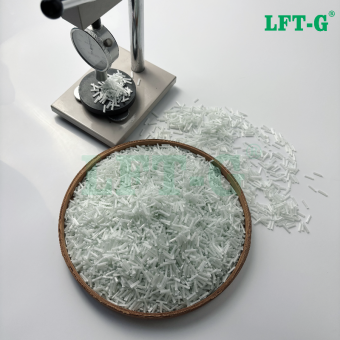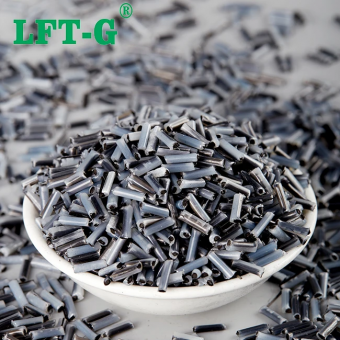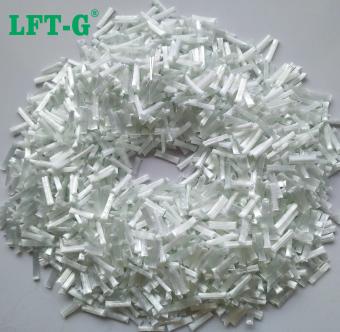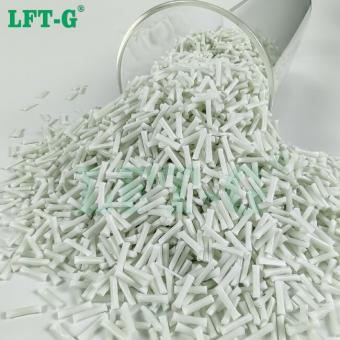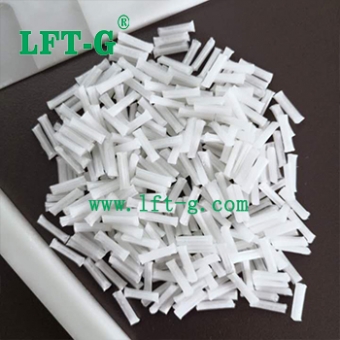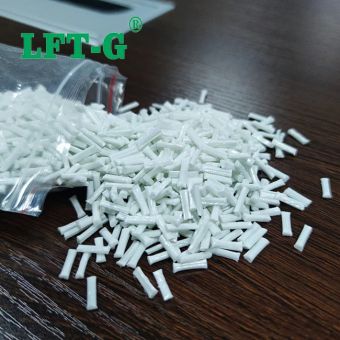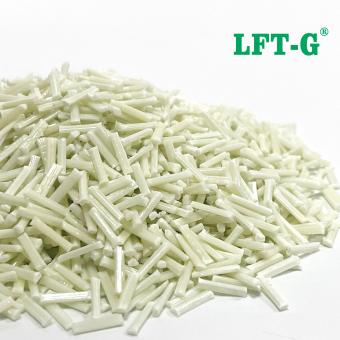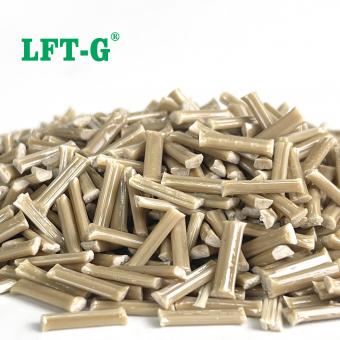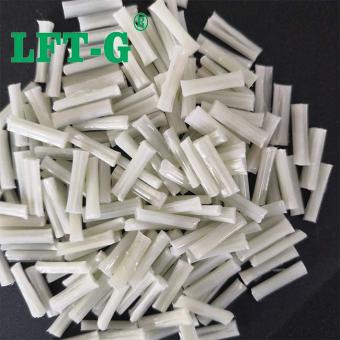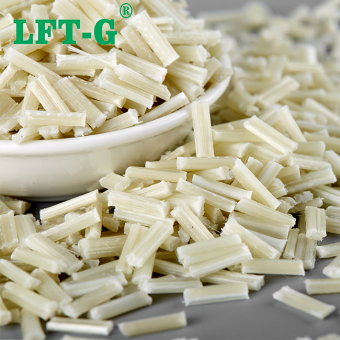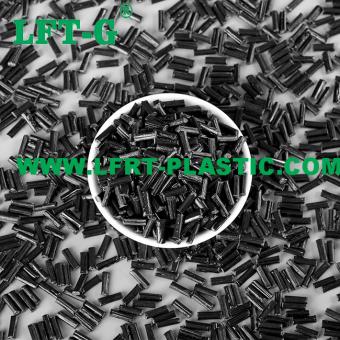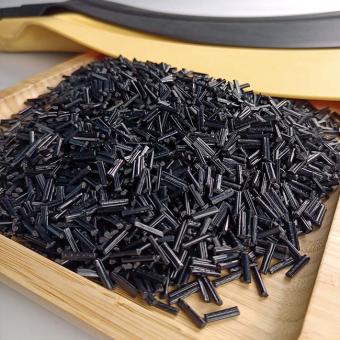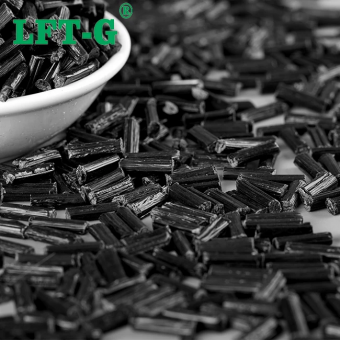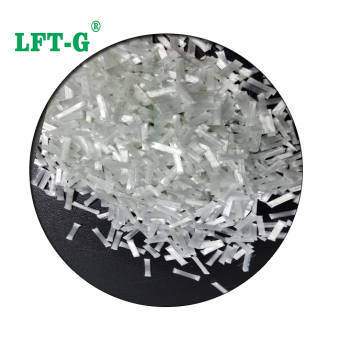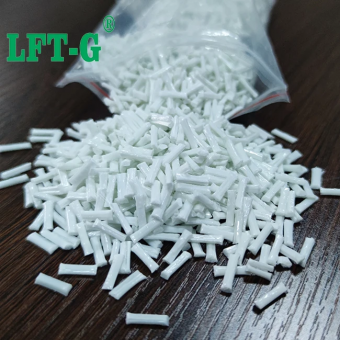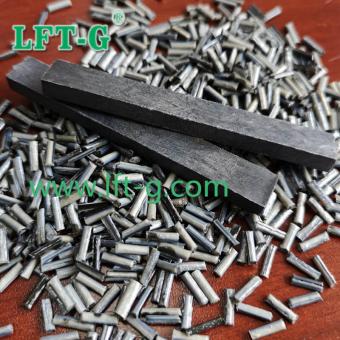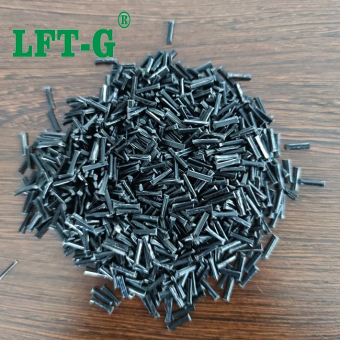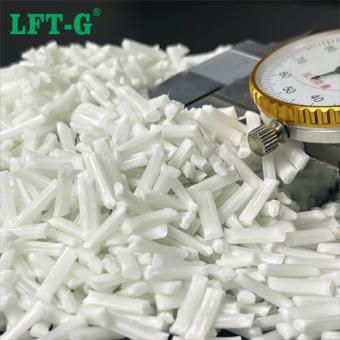-
Xiamen LFT-G Polyamide 6 Long Glass Fiber Reinforced Thermoplastic for automotive partsProduct grade: General grade, Toughen resistant grade Fiber specification: 20%-60% Product feature: High toughness, Low warpage, Light texture, etc Product application: Automotive, Electronic appliances, Sports equipment, Power tools, etc.
- High performance nylon 6 LGF
- Good appearance LFT materials polyamide 6
- 2023 Hot sell GF made in China pa6 modified plastic
- Supplier price better mechanical properties
- Sample provide car parts long cut piece fiber
- Good price high-strength components materials PA6 injection compounds
Tags :
-
Xiamen LFT-G reinforced Polyphthalamide filling long glass fiber injection moldingPPA-LGF PPA, full name polyphthalamide, is a semi-aromatic polyamide with no less than 55% terephthalic acid or phthalic acid as raw material, commonly known as aromatic high temperature nylon. PPA has better mechanical properties and high temperature resistance compared to traditional aliphatic nylon (PA6/PA66) materials. PPA materials have relatively low water absorption, good dimensional stability and good corrosion resistance. Glass fiber reinforced PPA composites have high temperature resistance, high strength and low density, and are considered to be the best resin to replace steel with plastic. Compared with traditional short fiber reinforced pellets, long glass fiber reinforced PPA composites have better physical and mechanical properties. Application Because high-temperature nylon can withstand high strength, high loads, and high temperatures in harsh environments, it is ideal for applications in engine areas (such as engine covers, switches, and connectors) as well as transmission systems (such as bearing cages), air systems (such as exhaust control systems), and air intake units. PPA engineering plastic is a high performance engineering plastic reinforced by fiber with high temperature nylon as the base material. The structure and crystalline characteristics of high-temperature nylon make it have more characteristics and excellent overall performance than nylon 66 and nylon 6 and other engineering plastics: strong rigidity, high hardness, high temperature resistance, good chemical resistance and low water absorption, dimensional accuracy and stability and low warpage, excellent fatigue resistance, in many fields including automotive parts, mechanical parts and electrical and electronic parts used in motor parts It is widely used in many fields including automotive parts, mechanical parts and electrical and electronic parts for motor parts, circuit breakers, etc. LGF VS SGF Other materials you may wonder About us Xiamen LFT composite plastic Co., Ltd is a brand-name company that focuses on LFT&LFRT. Long Glass Fiber Series (LGF) & Long Carbon Fiber Series (LCF). The company's thermoplastic LFT can be used for LFT-G injection molding and extrusion, and can also be used for LFT-D molding. It can be produced according to customer requirements: 5~25mm in length. The company's continuous infiltration reinforced thermoplastics have passed ISO9001&16949 system certification, and the products have obtained lots of national trademarks and patents. We will offer you 1. LFT&LFRT material technical parameters and leading edge design 2. Mold front design and recommendations 3. Provide technical support such as injection molding and extrusion molding
- ppa granules lgf30 GF PPA virgin grade
- best long glass fiber ppa lgf30 granules
- Polymer lgf PPA Virgin pure materials
- pla lgf30 pla granule price good price
- ppa granules lgf30 self factory made
- ppa lft glass fiber fiberglass modified plastic
Tags :
-
Xiamen LFT-G Polyphenyl Sulfide PPS filled carbon fiber flame retardant UL-94Polyphenylene sulfide is a new functional engineering plastic.
- Polyphenyl sulfide pps high temperature resistance
- PPS plastic thermoplastic resin carbon fiber
- Composite material PPS modified plastic filament
- Filling lcf 30 LFT CFRP carbon fiber reinforced
- High flame retardant PPS self factory made
- Factory use raw material can be recycled pps
Tags :
-
Xiamen LFT-G PP Polyphenylene with long carbon fiber thermoplastic resin original colorPP material Polypropylene fiber has remarkable performance. Compared with other fibers, polypropylene fiber has the lightest, warmest and most hydrophobic fiber properties. The density of polypropylene fiber is only 0.91g/cm3, which is the smallest among the five synthetic fibers and about 34% lighter than polyester fiber; the insulation rate of polypropylene fiber is 36.49%, which is the highest among the five synthetic fibers and 1.7 times that of polyester; the standard moisture regain rate of polypropylene fiber is almost zero, and the hydrophobic and moisture-conducting properties are the best. At the same time, polypropylene fiber has good acid and alkali resistance and heat aging properties. PP-LGF reinofrced material Long carbon fiber reinforced composites can solve your problems when other methods of reinforced plastics do not provide the performance you need or if you want to replace metal with plastic. Long carbon fiber reinforced composites offer significant weight savings and provide optimum strength and stiffness properties in reinforced thermoplastics. The excellent mechanical properties of long carbon fiber reinforced composites make it an ideal replacement for metals. Combined with the design and manufacturing advantages of injection molded thermoplastics, long carbon fiber composites simplify the re-imagining of components and equipment with demanding performance requirements. Its widespread use in aerospace and other advanced industries make it and a "high-tech" perception of consumers - you can use it to market products and create differentiation from competitors. Datasheet of PP-LCF Injection molding Aplication of PP-LCF More suitable for large parts and structural parts. Other application fields you can contact us for technical supports. Test 1. Heat Deflection Temperature Testing 2. Vicat Softening Temperature Testing 3. Tensile Testing 4. Flexural Strength Testing 5. Elongation Testing 6. Density Testing 7. Melt Flow Rate Testing 8. Impact Strength Testing. 9. Etc. Production process 1. The original carbon fiber is physically and chemically treated to remove impurities, improve surface activity, and enhance the mechanical properties and durability of the prepreg. 2. Add resin, curing agent, additives, etc. to form a formula to improve fluidity, hardness, and temperature stability. 3. The pretreated carbon fiber is placed on the machine and compounded with resin. 4. The machine solidifies the words and the two are fully bonded. 5. Cut into 5mm-24mm particles according to the needs of manufactured products。 Certification 1. Quality Management System ISO9001/16949 Certification 2. National Laboratory Accreditation Certificate 3. Modified Plastics Innovation Enterprise 4. Honorary Certificate 5. Heavy metal REACH & ROHS testing Frequently asked questions Q. What are the advantages of long carbon fiber materials? A. Thermoplastic LFT long carbon fiber material has high rigidity, good impact strength, low warpage, low shrinkage, electrical conductivity and electrostatic properties, and its mechanical properties are better than glass fiber series. Long carbon fiber has the characteristics of lighter and more convenient processing to replace metal products. Q. Are there any special process requirements of long carbon fiber injection molding products? A. We must consider the requirements of long carbon fiber for the injection molding machine screw nozzle, mold structure and injection molding process. Long carbon fiber is a relatively high cost material, and need to evaluate the cost performance problem in the selection process. Q. The cost of long fiber products is higher. Does it has a high recycling value? A. The thermoplastic LFT long fiber material can be recycled and reused very well
- Long carbon fiber Reinforced Polypropylene for electrial accessories
- self owing pp pellets producer whole sell
- best long carbon fiber pp lcf30 granules
- PLA Composite Pellets good price made in China
- Modified Plastic pellets home appliances resin
- pp modified granules manufacturer
Tags :
-
Xiamen LFT-G Polyphenyl sulfide fill Long Carbon Fiber Polymer PPSPolyphenylene sulfide is a new functional engineering plastic.
- Polyphenyl sulfide long carbon fibre
- PPS plastic rein forced compounds
- Composite material pps industrial use
- Filling lcf 30 pps composite plastic new materials
- High flame retardant car parts CFRP
- Factory use raw material modified plastic high performance
Tags :
-
Xiamen High toughness Thermoplastic Urethane filled Long Glass Fibertpu injection molding and extrusion grade polyurethane recycle material
- tpu long glass fiber thermoplasitc composite
- long glass fiber reinforced plastic
- tpu polyurethane plastic long glass fiber
- long fiber tpu thermoplastic modified plastic
- tpu and polyurethane lgf instead metal
- long fiber thermoplastic made in China manufacturer
Tags :
-
Xiamen LFT-G Polybutylene terephthalate Long Glass Fiber Reinforced CompoundsThey are frequently used to replace metal for applications in which light weighting, improved impact strength, elastic modulus, and material strength are required.
- PBT modified plastic gf long glass fiber
- PBT thermoplastic engineering polymer
- GFRP PBT high toughness and rigidity sample available
- LFT PBT glass fiber reinforcement polymer good price
- PBT higher performance light weight instead metal
- low warpage PA6 for car parts
Tags :
-
LFT-G Polyetheretherketone filling Long Carbon Fiber Polymers extra high strengthPEEK-Long carbon fiber Polyetheretherketone (PEEK), the complete English name for polyetheretherketone, is a specialty engineering plastic with excellent performance, and has more advantages than other specialty engineering plastics, such as wear resistance, high temperature resistance, high strength and high modulus, flame retardant and radiation resistant, and so on. In addition polyetheretherketone (PEEK) has good thermal stability and melt flow above the melting point, so polyetheretherketone (PEEK) also has the typical processing properties of thermoplastics. PEEK resin is nontoxic, lightweight, corrosion-resistant, and one of the closest materials to the human skeleton, which is well compatible with the musculature, so it is often used instead of metal to make human bones. Carbon fiber-reinforced PEEK composites make up for the weaknesses of toughness and deviations in impact strength. Carbon fiber-reinforced PEEK composites can exhibit high mechanical strength and hydrolytic stability under conditions such as hot water, steam, solvents, and chemical reagents, and can be used to prepare various medical devices that require high-temperature steam sterilization. Advantages of PEEK-LCF PEEK has high rigidity, good dimensional stability, low coefficient of linear expansion, and can withstand great stress without significant elongation over time, and its low density and good processing properties make it suitable for parts with high requirements for fineness. Among these elements, carbon fiber materials overlap highly with the characteristics of PEEK. Carbon fiber is not only one of the typical lightweight materials, it is also outstanding in terms of mechanical properties. As a result, carbon fiber reinforced PEEK composites can reduce weight by at least 70% compared to traditional metal materials. PEEK material itself is very wear-resistant, and good interface bonding with carbon fibers to further enhance its wear resistance, through the carbon fiber reinforced PEEK composite parts and cobalt alloy materials for wear comparison experiments, the results show that: at 23 ℃, using the M-200 wear machine at 400 rpm after 100 minutes of wear, found that the carbon fiber reinforced PEEK composite surface smooth The wear marks were small, and the carbon fiber bonded well with PEEK without fiber extraction. In contrast, the cobalt alloy surface wear marks are very obvious, even a large number of wear particles appear, the metal internal impurities image visible. PEEK exhibits high mechanical strength and hydrolytic stability in hot water, steam, solvents and chemical reagents, etc. Datasheet for reference PEEK-LCF application Q&A 1. What are the types of thermoplastic carbon fiber composites? Carbon fiber thermoplastic composites are composites with carbon fiber as the reinforcing material and thermoplastic resin as the matrix. From the reinforcement method of carbon fiber, it can be divided into long-cut carbon fiber (LCF) reinforced thermoplastic composites, short-cut carbon fiber (SCF) reinforced thermoplastic composites and continuous carbon fiber (CCF) reinforced thermoplastic composites. Long-cut carbon fiber and short-cut carbon fiber mainly refer to the application length of carbon fiber materials, there is no strict fixed distinction between the two, generally between a few millimeters to a few centimeters, the more common specifications are 6mm, 12mm, 20mm, 30mm, 50mm. Carbon fiber thermoplastic composites can also be classified according to the thermoplastic resin. There are many common thermoplastic resins, such as PE, PP, PVC, etc. However, thermoplastic resin composites with carbon fiber reinforcement are mostly used in aerospace, precision equipment and other demanding working environments, therefore, carbon fiber thermoplastic composites are more often made of polyether ether ketone (PEEK), PPS, polyimide ( PI), polyetherimide (PAI) and other mid- to high-end thermoplastic resins as the matrix to achieve the optimization of material performance. 2. How does thermoplastic carbon fiber composite material achieve low cost and environmental protection? Thermoplastic carbon fiber composites are used to make parts for high-end machinery. They have excellent machinability, vacuum forming, stamping mold plasticity, and bending processability. For example, Teijin has been able to add a recycling process to the process according to specific needs, and to shred and mold the corners of thermoplastic carbon fiber composite materials after stamping to make recycled materials for making small products or for molding nuts and studs on carbon fiber prototypes. This method can greatly reduce the loss of raw materials, improve the efficiency of the use of thermoplastic carbon fiber composite materials, reduce the overall cost, and thus achieve the purpose of environmental protection. In addition, thermoplastic carbon fiber composites can reduce the molding cycle time compared with thermoset carbon fiber composi...
- PEEK with long carbon fiber compounds
- Modified Plastic pellets peek engineering plastic
- factory in Xiamen thermoplastics
- peek cf30 injection molded 3D print
- PEEK pellets lcf 30 polymer resin carbon fibre
- self owing peek pellets reinforcement
Tags :
-
Xiamen LFT-G Polybutylene terephthalate Long Glass Fiber Reinforced CompoundsThey are frequently used to replace metal for applications in which light weighting, improved impact strength, elastic modulus, and material strength are required.view more
-
LFT Polyphenyl Sulfide PPS Long Carbon Fiber Reinforced flame retardantPolyphenylene sulfide is a new functional engineering plastic.view more
-
LFT virgin composite PEEK Long Carbon Fiber Reinforcement high strength and rigidityPEEK-Long carbon fiber Polyetheretherketone (PEEK), the complete English name for polyetheretherketone, is a specialty engineering plastic with excellent performance, and has more advantages than other specialty engineering plastics, such as wear resistance, high temperature resistance, high strength and high modulus, flame retardant and radiation resistant, and so on. In addition polyetheretherketone (PEEK) has good thermal stability and melt flow above the melting point, so polyetheretherketone (PEEK) also has the typical processing properties of thermoplastics. PEEK resin is nontoxic, lightweight, corrosion-resistant, and one of the closest materials to the human skeleton, which is well compatible with the musculature, so it is often used instead of metal to make human bones. Carbon fiber-reinforced PEEK composites make up for the weaknesses of toughness and deviations in impact strength. Carbon fiber-reinforced PEEK composites can exhibit high mechanical strength and hydrolytic stability under conditions such as hot water, steam, solvents, and chemical reagents, and can be used to prepare various medical devices that require high-temperature steam sterilization. Advantages of PEEK-LCF PEEK has high rigidity, good dimensional stability, low coefficient of linear expansion, and can withstand great stress without significant elongation over time, and its low density and good processing properties make it suitable for parts with high requirements for fineness. Among these elements, carbon fiber materials overlap highly with the characteristics of PEEK. Carbon fiber is not only one of the typical lightweight materials, it is also outstanding in terms of mechanical properties. As a result, carbon fiber reinforced PEEK composites can reduce weight by at least 70% compared to traditional metal materials. PEEK material itself is very wear-resistant, and good interface bonding with carbon fibers to further enhance its wear resistance, through the carbon fiber reinforced PEEK composite parts and cobalt alloy materials for wear comparison experiments, the results show that: at 23 ℃, using the M-200 wear machine at 400 rpm after 100 minutes of wear, found that the carbon fiber reinforced PEEK composite surface smooth The wear marks were small, and the carbon fiber bonded well with PEEK without fiber extraction. In contrast, the cobalt alloy surface wear marks are very obvious, even a large number of wear particles appear, the metal internal impurities image visible. PEEK exhibits high mechanical strength and hydrolytic stability in hot water, steam, solvents and chemical reagents, etc. Datasheet for reference PEEK-LCF application Q&A 1. What are the types of thermoplastic carbon fiber composites? Carbon fiber thermoplastic composites are composites with carbon fiber as the reinforcing material and thermoplastic resin as the matrix. From the reinforcement method of carbon fiber, it can be divided into long-cut carbon fiber (LCF) reinforced thermoplastic composites, short-cut carbon fiber (SCF) reinforced thermoplastic composites and continuous carbon fiber (CCF) reinforced thermoplastic composites. Long-cut carbon fiber and short-cut carbon fiber mainly refer to the application length of carbon fiber materials, there is no strict fixed distinction between the two, generally between a few millimeters to a few centimeters, the more common specifications are 6mm, 12mm, 20mm, 30mm, 50mm. Carbon fiber thermoplastic composites can also be classified according to the thermoplastic resin. There are many common thermoplastic resins, such as PE, PP, PVC, etc. However, thermoplastic resin composites with carbon fiber reinforcement are mostly used in aerospace, precision equipment and other demanding working environments, therefore, carbon fiber thermoplastic composites are more often made of polyether ether ketone (PEEK), PPS, polyimide ( PI), polyetherimide (PAI) and other mid- to high-end thermoplastic resins as the matrix to achieve the optimization of material performance. 2. How does thermoplastic carbon fiber composite material achieve low cost and environmental protection? Thermoplastic carbon fiber composites are used to make parts for high-end machinery. They have excellent machinability, vacuum forming, stamping mold plasticity, and bending processability. For example, Teijin has been able to add a recycling process to the process according to specific needs, and to shred and mold the corners of thermoplastic carbon fiber composite materials after stamping to make recycled materials for making small products or for molding nuts and studs on carbon fiber prototypes. This method can greatly reduce the loss of raw materials, improve the efficiency of the use of thermoplastic carbon fiber composite materials, reduce the overall cost, and thus achieve the purpose of environmental protection. In addition, thermoplastic carbon fiber composites can reduce the molding cycle time compared with thermoset carbon fiber composi...
- PEEK with long carbon fiber
- Modified Plastic pellets special engineering plastic
- peek cf30 instead metal high demanding
- PEEK pellets lcf 30 polymer
- self owing peek pellets
Tags :
-
Xiamen LFT PP Polypropylene engineeing plastic long glass fiber composite granules 12mmWhat is long glass fiber? Long glass fiber reinforced plastic is on the basis of the original pure plastic, adding long glass fiber and other additives, so as to improve the scope of use of materials. Why filling Long Glass Fiber? 1. After long glass fiber reinforcement, long glass fiber is a high temperature resistant material, therefore, the heat resistance temperature of reinforced plastics is much higher than before without long glass fiber, especially nylon plastics; 2. After long glass fiber reinforcement, due to the addition of long glass fiber, limited the mutual movement between polymer chains of plastics, therefore, the shrinkage rate of reinforced plastics decreases a lot, rigidity is greatly improved; 3. After long glass fiber reinforcement, the reinforced plastic will not stress crack, at the same time, the anti-impact performance of plastic is improved a lot; 4. After long glass fiber reinforcement, long glass fiber is a high strength material, which also greatly improves the strength of plastic, such as: tensile strength, compression strength, bending strength, improve a lot; 5. Long glass fiber reinforced after, due to the addition of long glass fiber and other additives, the combustion performance of reinforced plastics decreased a lot, most of the material can not ignite, is a kind of flame retardant material. Why choose Long Glass Fiber instead of Short Glass Fiber? Compared with short fiber reinforced thermoplastic composites, LFT has the following advantages: • Long fiber length, significantly improve the mechanical properties of products. • High specific stiffness and strength, good impact resistance, especially suitable for automotive applications. • Improved creep resistance, good dimensional stability, high parts forming accuracy. • Excellent fatigue resistance. • Better stability in hot and humid environments. • The fiber can move relatively in the molding mold during the molding process, and the fiber damage is small. Appearance of PP-LGF Application of PP-LGF Automotive parts Front end module, door module, shift mechanism, electronic accelerator pedal, dashboard skeleton, cooling fan and frame, battery carrier, bumper bracket, underbody protection plate, sunroof frame, etc., used to replace reinforced PA or metal materials. Household appliance Washing machine drum, washing machine triangle bracket, one brush machine drum, air conditioning fan, etc., used to replace short glass fiber reinforced PA, APS metal materials. Communications, electronics, electrical appliances High-precision connectors, igniter components, coil shaft, relay base, microwave oven transformer coil frame/frame, electrical connector, solenoid valve package, scanner components, etc. Others Power tool housing, water pump or water meter housing, impeller, bicycle skeleton, skis, ground locomotive pedals, military/civil safety helmets, safety shoes, etc. are used to replace short glass fiber reinforced PA, PPO, etc. Datasheet for reference About us Xiamen LFT composite plastic Co., Ltd. is a brand-name company that focuses on LFT&LFRT. Long Glass Fiber Series (LGF) & Long Carbon Fiber Series (LCF). The company's thermoplastic LFT can be used for LFT-G injection molding and extrusion, and can also be used for LFT-D molding. It can be produced according to customer requirements: 5~25mm length. The company's long-fiber continuous infiltration reinforced thermoplastics have passed ISO9001 &16949 system certification, and the products have obtained lots of national trademarks and patents. We will offer you: 1. LFT&LFRT material technical parameters and leading edge design; 2. Mold front design and recommendations; 3. Provide technical support such as injection molding and extrusion molding.
- Polypropylene filling lgf GFRP 30
- thermopalstic Polymer virgin grade
- LFT-G car parts home appliance parts
- PP resin GF made in China modified plastic
- long fiber compounds pp instead metal and steel
- injection molding pp composite
Tags :

 e-mail
e-mail English
English français
français Deutsch
Deutsch русский
русский italiano
italiano español
español português
português العربية
العربية 日本語
日本語 한국의
한국의 中文
中文




